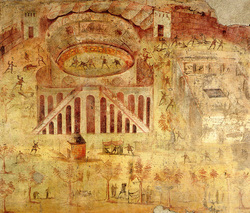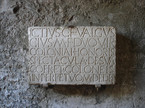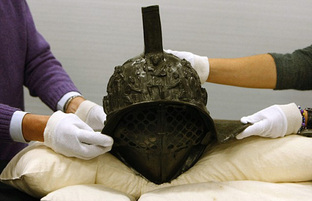THE AMPHITHEATER
The Amphitheater was the first of its kind to be constructed out of stone and was supposedly built around 70 BC to exhibit gladiatorial games and killings. It was of oval shape, had three main divisions (Ima cavea, media cavei and summa cavea), 2 main entrances, narrow death passages and catered for 20,000 people. It provided the Roman people with a great source of entertainment as gladiators battled one another and were often slaves or criminals. We are aware of this due to the excavation of four gladiators in the detention room whom had not been released at the time of the eruption by their trainers and were instead left to die.

The image seen to the left is of a painting that was founded in a house owned by Actius Anicetus that was close by to the excavated amphitheater which depicts the riot that broke out in 59AD as Gladiatorial battles were well known for provoking violence. A fight developed between the neighboring town of Nuceria and the towns people of Pompeii. Numerous Nucerians were murdered and injured and after appealing to the emperor the Amphitheater was closed for a period of ten years.
This painting informs us that Gladiatorial battles were a popular form of entertainment in Pompeii and people felt passionate about the activities that took place The painting was possibly created as a celebration of the reopening of the amphitheater after its reconstruction from the earth quake that struck in AD 62. Not only does this image depict the event of the riot but also roughly illustrates certain aspects of the venue. This includes the private boxes reserved for the aristocratic women who by the social legislation of Augustus were restricted from the other areas and were to occupy the upper most seats. However there are limitations to this image as the number of arches that are seen beneath the double staircase that lead to the terrace is incorrect as 11 are portrayed yet there are only 6. This provides us with the understanding that even primary sources from the excavations have their limitations.
If the eruption had not occurred then the Amphitheater would have developed as time went on and adapted to the new constructions and styles of the Roman people. It would have architecturally been altered and could possibly have been replaced by new infrastructures that were seen to be more appropriate and sturdy. Because the amphitheater was buried it froze the architectural structure and inspired modern architects to construct building that resembled certain aspects of the classical architecture that was used for example the columns and arches.
This painting informs us that Gladiatorial battles were a popular form of entertainment in Pompeii and people felt passionate about the activities that took place The painting was possibly created as a celebration of the reopening of the amphitheater after its reconstruction from the earth quake that struck in AD 62. Not only does this image depict the event of the riot but also roughly illustrates certain aspects of the venue. This includes the private boxes reserved for the aristocratic women who by the social legislation of Augustus were restricted from the other areas and were to occupy the upper most seats. However there are limitations to this image as the number of arches that are seen beneath the double staircase that lead to the terrace is incorrect as 11 are portrayed yet there are only 6. This provides us with the understanding that even primary sources from the excavations have their limitations.
If the eruption had not occurred then the Amphitheater would have developed as time went on and adapted to the new constructions and styles of the Roman people. It would have architecturally been altered and could possibly have been replaced by new infrastructures that were seen to be more appropriate and sturdy. Because the amphitheater was buried it froze the architectural structure and inspired modern architects to construct building that resembled certain aspects of the classical architecture that was used for example the columns and arches.

Here is an inscription found in the amphitheater that indicates that it was built in honor of the first Roman colonist and it is said that this plark was created after the 62 AD earth quake, before the opening of the venue once more.

This image is of a 2,000 year old Gladiators helmet that survived the eruption of Mt. Vesuvius and was found in the Amphitheater in Pompeii 200 years ago. It is said to have been worn by a Murmillo who was a type of Gladiator during the Roman Imperial age. Shin guards and other forms of Armour were also excavated and is said that the Murmillo would have worn Loincloth, a heavy belt, short greaves on the lower parts of his legs "a linen arm protector to protect his right arm, and the curved rectangular shield of the Roman legionary."
This image of a helmet from the times of the Gladiator informs us that the gladiator fights were a grand form of entertainment as numerous excavations depict Armour that the gladiators would have worn. By excavating these items we know that the activities that occurred inside the Amphitheater were vicious, violent and deadly. The intense craftsmanship of the helmet portrays how well protected the needed to be to survive the brutal killings that took place. This helmet is a direct artifact that provides evidence that reinforces the Gladiator himself and the battles that occurred.
If this helmet had not been preserved by the eruption the idea of the gladiator would almost be seen as mythical as times have changed drastically since then and it is almost unthinkable to send men into a battle of the death. The barbaric actions of these gladiators was preserved by the eruption which depicts the daily life of many people, whether they themselves were gladiators or if they went along to watch. The excavations indicate that the amphitheater was used for entertainment which was carried out by victims such as the Murmillo who once wore this helmet. It not only preserves the actual helmet but preserves the reality of the gladiator.
This image of a helmet from the times of the Gladiator informs us that the gladiator fights were a grand form of entertainment as numerous excavations depict Armour that the gladiators would have worn. By excavating these items we know that the activities that occurred inside the Amphitheater were vicious, violent and deadly. The intense craftsmanship of the helmet portrays how well protected the needed to be to survive the brutal killings that took place. This helmet is a direct artifact that provides evidence that reinforces the Gladiator himself and the battles that occurred.
If this helmet had not been preserved by the eruption the idea of the gladiator would almost be seen as mythical as times have changed drastically since then and it is almost unthinkable to send men into a battle of the death. The barbaric actions of these gladiators was preserved by the eruption which depicts the daily life of many people, whether they themselves were gladiators or if they went along to watch. The excavations indicate that the amphitheater was used for entertainment which was carried out by victims such as the Murmillo who once wore this helmet. It not only preserves the actual helmet but preserves the reality of the gladiator.
